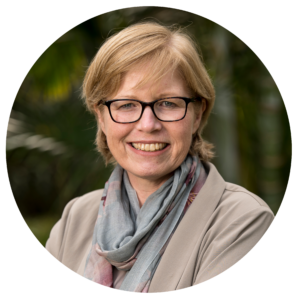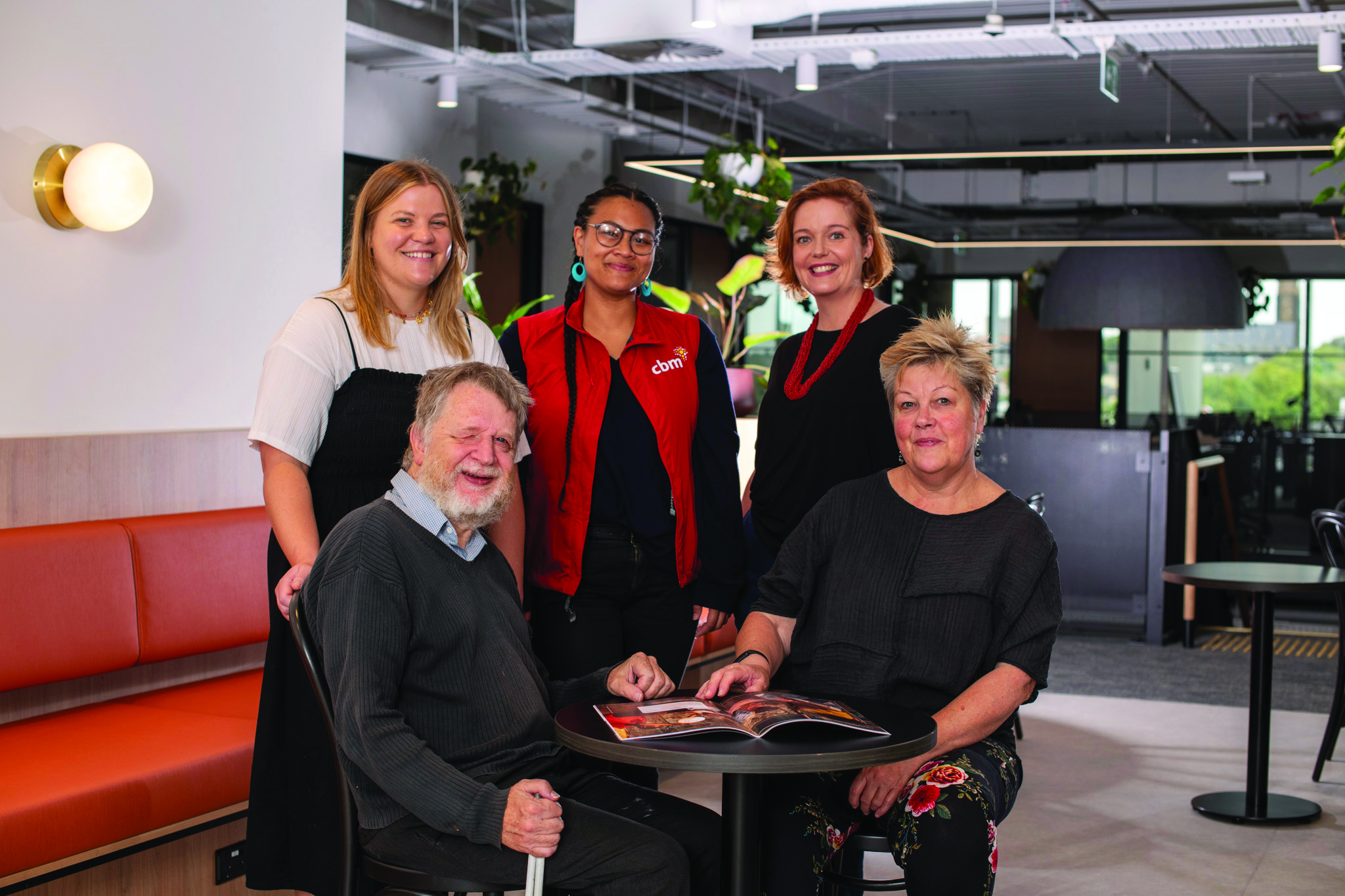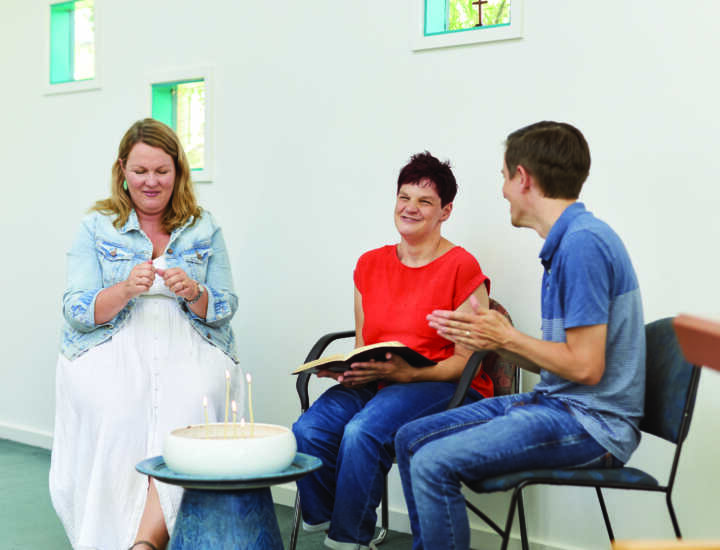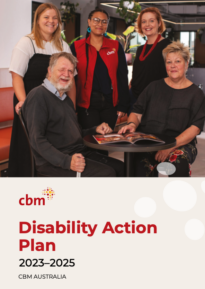About CBM
We are a Christian international development organisation committed to supporting people with disabilities in the poorest countries around the world.
With more than 45 years in Australia and 115 years internationally, we remain the only Australian development organisation working to end the cycle of poverty and disability.
Our Vision is for an inclusive world in which all people with disabilities enjoy their human rights and achieve their full potential.
At CBM Australia, we live out our Values:
We champion inclusion
We pursue excellence
We strive for justice
We embrace partnership
We live with integrity
Message from our Chief Executive Officer
 Inclusion is one of CBM Australia’s core values, defining and guiding our organisation’s culture and ways of working. We recognise that inclusion is not just an outcome where people with disabilities can claim their human rights on an equal basis with others, but also the process through which we continually work to identify and address the barriers that people with disabilities face in all aspects of life. As such, we are committed to addressing and removing these barriers in CBM Australia’s workplace, programs and operations.
Inclusion is one of CBM Australia’s core values, defining and guiding our organisation’s culture and ways of working. We recognise that inclusion is not just an outcome where people with disabilities can claim their human rights on an equal basis with others, but also the process through which we continually work to identify and address the barriers that people with disabilities face in all aspects of life. As such, we are committed to addressing and removing these barriers in CBM Australia’s workplace, programs and operations.
We know that achieving disability inclusion depends on strong leadership, commitment from all staff, and the active participation and meaningful engagement of people with disabilities at all levels within the organisation. We acknowledge the value that people with lived experience of disability bring to all aspects of our work – from the many contributions of our staff with disabilities in Australia, to those of our supporters with disabilities, to the work performed by the Organisations of People with Disabilities (OPDs) that we are honoured to partner with overseas.
This Disability Action Plan (DAP) will guide CBM Australia’s workplace. It has been developed with initial input from a group of staff members with lived experience of disability, and thereafter in partnership with their nominated representatives; together in consultation with the departmental leads who will be responsible for ensuring progressive achievement of the targets. Our goal in taking this approach has been to ensure that our DAP addresses the needs identified by people with disabilities, through actions that are tailored to be feasible within our resources and scope. The result is a comprehensive DAP, informed by the voices of people with disabilities, that strikes a balance between aspiration and practicality. I often speak to our staff of the need to undertake our work with servant leadership, and it is with this in mind that I present this DAP. We will work together with our staff towards its achievement over the next three years.
Message from our Disability Inclusion Group
CBM’s Disability Inclusion Group (DIG) is a voluntary staff-led peer group of people with lived experience of disability. This group offers a safe space within CBM for employees to share their experiences, wins, challenges and concerns regarding disability inclusion and accessibility in the workplace.
Depending on the nature of such issues, avenues can be created to safely and confidentially address and express such concerns to the appropriate management to prompt changes. These avenues do not seek to replace or replicate existing structures, but rather offer another pathway to raise particular issues around disability inclusion.
The DIG has been consulted throughout the development of this Disability Action Plan.
The DIG commends the author/s of the DAP, teams within CBM involved in its development, as well as CBM’s CEO, Jane Edge, for the commitment to building a more inclusive organisation for staff with disabilities; to build all staff capacity in disability inclusion; and strengthen inclusion in CBM’s business processes.
The DIG acknowledges the commitment of all teams to achieve the DAP goals and commits itself to working collaboratively to support the achievement of its targets.

Introduction
CBM Australia is a Christian international development organisation. Our vision is for an inclusive world in which all people with disabilities enjoy their human rights and achieve their full potential. We work with local partners in low and middle-income countries to address barriers experienced by people with disabilities, in areas such as healthcare, education and livelihoods. We also have a strong advocacy and advisory focus, influencing Australian politicians and stakeholders within the international development sector to ensure their workplaces, policies and practices are disability inclusive. Additionally, we work with Australian supporters, including our individual donors; two-thirds of whom identify as people with disabilities or caring for people with disabilities.
For our staff, we strive for an inclusive workplace in which staff with disabilities realise their full potential: firstly, because this aligns with their human rights and secondly because it will benefit our organisation as we recognise that people with disabilities have unique contributions to bring to our work and mission.
We want to champion inclusion and become an employer of choice for people with disabilities. We also recognise that many of our supporters and other stakeholders that we engage with – from volunteers to our partners in both Australia and overseas – will have disabilities, so our ways of working must be fully inclusive and accessible.
We recognise that achieving this will require more than good intentions. People with disabilities face a range of individual and structural barriers in gaining and keeping employment, and community access, due to physical, communication, attitudinal and social barriers. Inclusion seeks to address this by considering the attitudes, behaviours and systems in our workplace and community which may be discriminatory. It challenges us to listen and reflect on how we can improve. Inclusion requires us to commit to change and to continuous improvement.
The question we seek to answer is: how are we currently enabling our ambition to be fully inclusive, and what can we do better?
What is disability?
People with disabilities make up almost one in five Australians, forming a strong part of CBM Australia’s staff, supporters and other audiences.
Disability is an evolving concept. Globally, the way we understand and respond to disability has changed. The most widely accepted and endorsed definition of disability is within the Convention on the Rights of Persons with Disabilities (UNCRPD) which states:
“Persons with disabilities include those who have long-term physical, mental, intellectual or sensory impairments which in interaction with various barriers may hinder their full and effective participation in society on an equal basis with others.”
According to the social model of disability, “disability” is socially constructed and arises from the interaction between people living with impairments and the physical, attitudinal, communication and social barriers in the environments surrounding them. The rights-based approach says that disability is a normal part of humanity and that everyone is created equal.
It is only when society puts up barriers that people with disabilities are excluded from everyday life. The emphasis is on environments to change and accommodate to enable people with disabilities to participate in society on an equal basis with others. This supports the view that people with disabilities have a right to be fully participating citizens on an equal basis with others.
Experiences of disability are diverse and experienced by individuals in unique ways. Two people with the same impairment type may have completely different lives depending on their gender, age and ethnicity, where they live, their access to services, and how their communities perceive and include them.
Further definitions of disability can be found in The Disability Discrimination Act 1992 and the United Nations Convention on the Rights of People with Disabilities.
Purpose
This Disability Action Plan (DAP) 2023-2025 outlines CBM Australia’s commitment to enhancing the inclusion and accessibility needs of people with disabilities.
This plan focuses on improving accessibility, participation and employment outcomes for people with disabilities across CBM Australia’s various stakeholders.
Disability Action Plan
This Disability Action Plan (DAP) 2023-2025 outlines CBM Australia’s commitment to enhancing the inclusion and accessibility needs of people with disabilities.

Scope and structure
CBM Australia recognises that while inclusion can be achieved at any one point in time, it is dynamic and evolving depending on ever-changing environments, people and circumstances. Inclusion requires ongoing commitment to improvement and to embedding accessibility in all areas of the workplace.
A Disability Action Plan (DAP) requires continuous quality improvement. We are committed to our initial three-year DAP with a mid-term review. Our goals speak to continuous improvement and aim to strike the balance between aspirational and practical targets, while recognising the non-negotiable rights of people with disabilities.
The DAP sets out both high-level aspirational aims as well as practical goals and targets that are achievable within the timeframes, resources and capacity of the organisation. Deadlines, responsible parties and measures of success are attached to each target. We chose this process to recognise that it will take time to achieve the structural and sustainable change needed to become a fully inclusive organisation, requiring us to work systemically from our current position.
Our Disability Action Plan
Aspirational aim 1: Our organisational commitment to inclusion
CBM Australia builds an inclusive culture where all employees, particularly those with lived experience of disability, trust that disability inclusion is a high priority and is well understood and practiced by the organisation.
GOAL 1.1
Ensure active participation and meaningful engagement of people with disabilities at all levels of the organisation in development of a disability-inclusive culture at CBM Australia
- Target 1.1.1
- Establish regular meetings and awareness of the DEN and DIG
- Timing
- Q3 2022
- Accountability
- Lead: P&C (DEN), DIG
- Success measure
- DAP is informed by whole organisation, including those with lived experience of disability. Meaningful engagement of all levels of organisation in the DEN, DIG and DAP.
- Target 1.1.2
- Establish Disability Champion role
- Timing
- Q3 2022
- Accountability
- CEO
- Success measure
- CEO is CBM Australia’s Disability Champion. The CEO attends DEN periodically and is available to DIG for informal dialogue.
GOAL 1.2
Build a high-trust culture based on sound understanding of disability inclusion informed by people’s lived experience
- Target 1.2.1
- Disability Champion to have meaningful engagement with DEN and DIG, including seeking and responding to feedback
- Timing
- Q3 2022
- Accountability
- CEO, DEN
- Success measure
- Disability Champion in place and at least bi-monthly engagement with DEN and DIG. DEN and DIG report Disability Champion as a useful mechanism at six-monthly review of this target.
- Target 1.2.2
- Celebrate staff with disabilities (e.g., during CEO snapshots, CBM staff days, as well as internal International Day of People with Disabilities event/celebration to be designed in conjunction with DEN/DIG), encourage storytelling by employees with disabilities and raise awareness of our DAP commitments, in conjunction with DEN and DIG
- Timing
- Q4 2022
- Accountability
- SMT, P&C and managers
- Success measure
- Continued and appropriate highlighting of stories of employees with disabilities within the following gatherings:
- CEO snapshots
- Devotions
- Whole-of-team meetings
- Cross-team meetings
- Celebration of IDPD at a CBM internal event.
- Target 1.2.3
- New staff induction includes introductory training on disability inclusion
- Timing
- Q2 2023
- Accountability
- Lead: P&CP&C, all managers, DIG / DEN members
- Success measure
- Onboarding pack/ slides/training developed to increase disability-inclusive practice at CBM. Standard PowerPoint will include:
- Disability inclusion practices including availability for reasonable workplace adjustments (RWAs)
- Opportunities for employees to participate (DIG/ DEN).
DEN/DIG organise a lunch time ‘brown bag’ session/webinar on disability inclusion once per year for new employees.
- Target 1.2.4
- Sustain ongoing disability inclusion training for all employees (annual), volunteers and Board members covering issues including inclusive language, inclusive practices for the workplace, understanding disability barriers and enablers, disability and diversity
- Timing
- Q3 2023
- Accountability
- P&C, managers, Company Secretary
- Success measure
- e-Learning module sourced or created and offered to staff on commencement at CBM and annually thereafter as part of a corporate learning program, and on commencement as a Board Member. Ad hoc training and/ or communications where guidelines and practices are updated/ changed.
- Target 1.2.5
- Ensure that general staff surveys meet accessibility requirements Develop a clear accessibility guidance for all internal communications and documentation across CBM Australia (aligned with 3.2.1) Framework to include minimum requirements matched to communication type and audience
- Timing
- Q1 2023
- Accountability
- Lead: OSS in consultation with IAG
- Success measure
- Accessibility guidance exists. Surveys comply with guidelines.
GOAL 1.3
Governance framework ensures improved and integrated disability inclusion across the organisation
- Target 1.3.1
- DEN participates in planned reviews of selected and relevant policies and standards to strengthen disability inclusion perspectives
- Timing
- From Q2 2023
- Accountability
- DEN Co-Chairs / P&C
- Success measure
- New/updated policies and standards are published on InfoHub and reflect consideration of disability inclusion perspectives.
- Target 1.3.2
- Ensure the inclusive design of staff data/survey points regarding employee experience of disability inclusion and ensure data collected from staff with lived experience is tagged for separate reporting and monitoring of trends over time
- Timing
- Q3 2023
- Accountability
- Lead: P&C
- Success measure
- Collection process will invite respondents to indicate anonymously if they have a lived experience of disability, for data analysis purposes. Data is collected and monitored annually from employees about perceptions of disability inclusion within CBM, including disaggregated data for those with lived experience. Data is analysed and reported to the CEO annually.
- Target 1.3.3
- Develop reporting framework against DAP as part of overall organisation strategy reporting (see further ‘Reporting’ below)
- Timing
- Q1 2023
- Accountability
- Lead: DAP Steering Committee with DEN Chairs
- Success measure
- DAP implementation will be incorporated as a headline activity into 2023 annual planning under the “Strengthen Foundations” theme of Strategic Directions 2023-2026.
Aspirational aim 2: Our people
CBM Australia builds and embeds practices that identify and remove the systemic and individual barriers that people with disabilities face in all stages of employment (including vocational training, recruitment, retention and promotion). CBM Australia seeks to sustain a minimum of 15 per cent of staff with disabilities through this practice and see staff with disabilities promoted through leadership roles.
GOAL 2.1
Improve recruitment practices
- Target 2.1.1
- Where appropriate vacancies exist, CBM to engage with university programs for graduates with disabilities, to seek opportunities to recruit entry level candidates with disabilities
- Timing
- Q3 2024
- Accountability
- P&C
- Success measure
- Relationship with universities is established to allow for graduates with disabilities to be considered for early career opportunities to enter employment with CBM, where relevant and appropriate vacancies exist.
- Target 2.1.2
- All recruitment activities promote the desire to attract and support people with disabilities to apply and be successful for a role at CBM
Include disability employment networks in all recruitment searches - Timing
- Q2 2023
- Accountability
- Lead: P&C
- Success measure
- CBM job ads reflect our commitment to inclusive employment practices for people with disabilities.
CBM recruitment materials and processes meet agreed accessibility standards.
- Target 2.1.3
- Make CBM Australia’s approach to reasonable workplace adjustments (RWAs) clear throughout recruitment process (see also 2.3.1)
Develop a process for application, documentation and decision making, in the event that the candidate is successful in securing the role at CBM
Commit to ensuring CBM-agreed RWAs for successful candidates are in place within four weeks of the commencement date, with the aim of having support in place by the commencement date - Timing
- Q2 2023
- Accountability
- Lead: P&C
- Success measure
- Candidates are aware of the opportunity to request RWAs.
A process exists for application, documentation and decision making, in the event that the candidate is successful in securing the role.
CBM Australia-agreed RWAs for successful candidates are in place within four weeks of the commencement date, with the aim of having support in place by the commencement date.
- Target 2.2
- Review and improve pathways to career development
- 2.2.1 Undertake a review process seeking feedback on current development pathways and career development activities, to identify and address barriers for staff with disabilities
- Timing
- 2025
- Accountability
- Lead: Director, Capability and Business Performance
- Success measure
- Review is undertaken that provides valuable insights about future directions on disability inclusion at CBM and clear next steps for reduction of identified barriers.
- Target 2.2.2
- Develop systems to safely identify the number of staff with disabilities and their respective levels of employment, and track this over time
- Timing
- Q1 2023
- Accountability
- P&C
- Success measure
- One anonymous all-staff survey per year (see 1.3.2) includes questions, developed with technical input from IAG, to identify number of staff with disabilities, optional specificity on disabilities, and their respective levels of employment (noting that data will be limited to those choosing to disclose their disability).
Incorporate into regular SMT reporting and to Board as appropriate.
Summary information is available to staff via InfoHub.
GOAL 2.3
Reasonable Workplace Adjustments for staff
- Target 2.3.1
- Develop a Reasonable Workplace Adjustment (RWA) Standard with a clear process for application, documentation and decision making, and clarity of roles for applicant, people managers, P&C and SMT
Introduce and promote this to staff, managers, and related functions to ensure it is effective - Timing
- Q1 2023
- Accountability
- Lead: P&C
- Success measure
- A CBM Reasonable Workplace Adjustment (RWA) Standard and process is published and made available to staff.
Reporting on activity related to the RWA Standard is included in monthly reporting to SMT including metrics on timing associated with turnaround of requests.
- Target 2.3.2
- Revise the Disability Inclusion standard to align with the RWA standard
- Timing
- Q2 2023
- Accountability
- Lead: P&C with OSS
- Success measure
- Standard is reviewed to ensure alignment.
- Target 2.3.3
- Review the Flexible Working Arrangements and Working from Home Standard to align with the RWA Standard
- Timing
- Q2 2023
- Accountability
- Lead: P&C with OSS
- Success measure
- Standard is reviewed to ensure alignment
Aspirational aim 3: Our accessibility
CBM Australia ensures that all its built and virtual environments, spaces and communications are accessible and inclusive.
GOAL 3.1
Built environment complies with accessibility standards
- Target 3.1.1
- All facilities used by CBM comply with accessibility standards for built environment in Australia and meet the accessibility needs of our staff
- Timing
- Q4 2023
- Accountability
- Lead: CFO
- Success measure
- DEN and DIG provide positive feedback on facilities every six months.
CBM advocates to rectify any shortfalls identified.
- Target 3.1.2
- Embed consultation with DEN and DIG into fit-out design for CBM’s office space in Blazey Street, Richmond
- Timing
- Q1-Q3 2023
- Accountability
- Lead: CFO
- Success measure
- Undertake consultation process with all employees and external consultant specialising in office fit out, with opportunity for particular input by DEN and DIG.
DEN and DIG provide positive feedback on homebase design process at six-monthly review of this target.
A strong focus on accessibility is embedded within the design process.
The design of the new building selected and purchased meets accessibility building standards.
GOAL 3.2
Events and meetings ensure consistent disability inclusion practices
- Target 3.2.1
- Review and consolidate the Accessible Information Guide and Accessible Hybrid Meeting guide into a single document and align these with CBM Australia’s branding guidelines
- Timing
- Q1 2023
- Accountability
- P&C / OSS
- Success measure
- Guide is published, promoted and made readily available on InfoHub.
Feedback mechanisms are provided to improve practice iteratively over time.
Monitoring of inclusive practice is undertaken regularly.
- Target 3.2.3
- Regular in-person and virtual meetings and gatherings of CBM staff meet agreed and documented
Accessibility Standards, with support for meeting conveners and leaders to align practice to the guidelines - Timing
- Q1 2023
- Accountability
- OSS/ department administrators, managers
- Success measure
- Managers, department administrators and other relevant staff have reviewed the guidelines and the implementation support material (video, etc).
DEN and DIG report improvement in inclusive meeting practices in six-monthly review of this target.
- Target 3.2.4
- CBM-initiated meetings and gatherings are promoted as disability inclusive and attendees are asked to share any additional accessibility needs in advance
- Timing
- Q1 2023
- Accountability
- Directors, department administrators
- Success measure
- Accessibility requirements are known and provided for.
- Target 3.2.5
- Where feedback is formally gathered for internal or external events, include a question (specific for that event) related to inclusive practice.
- Timing
- Q1 2023
- Accountability
- OSS / department administrators
- Success measure
- Meaningful information on inclusive practices is collected through formal feedback forms.
GOAL 3.3
Improved accessibility and inclusion in external engagement
- Target 3.3.1
- Research and develop a guideline for when an Easy English version of a publication should be developed according to audience type
This will then form part of the External Communication Process (current PE Process), which is a part of our evidence for DFAT compliance
This will come after training and identification of external provider - Timing
- Q2 2023
Q4 2023
Q1 2023 - Accountability
- PE
- Success measure
- Audience and success measures are determined prior to starting any external communication work and the step is recorded as part of the External Communication Process.
- Target 3.3.2
- All external communications identified in guideline 3.3.1 to be in Easy English, with relevant staff trained in writing and producing documents in Easy English
- Timing
- Q1 2024
- Accountability
- PE
- Success measure
- Easy English training is provided to key staff in each department.
All external documents identified in the framework are in Easy English.
- Target 3.3.3
- Annual accessibility review by available DIG/ DEN members and specialised external agency of materials (such as website, social media and reports) to identify areas of inaccessible communications and provide succinct overview of these to Public Engagement leadership and CEO
- Timing
- Q2 2023
- Accountability
- PE
- Success measure
- Website continuously improved to retain its AA rating and other channels are constantly improving.
- Target 3.3.4
- Develop activity plan with timeframe to address identified accessible communication gaps pursuant to 3.3.3, including training of staff regarding accessibility requirements to ensure these are met in future communications
- Timing
- Q3 2023
- Accountability
- PE
- Success measure
- Activity plan is developed, including identification of gaps and process to amend these.
Budget is confirmed for 2024 to implement activity plan.
- Target 3.3.5
- Take all measures to implement activity plan
- Timing
- Q4 2023 – Q4 2025
- Accountability
- PE
- Success measure
- Activity Plan is implemented.
- Target 3.3.6
- Develop framework in collaboration with key stakeholders to ensure people with disabilities are consulted in the design stage of significant product and platform changes
Take all measures to implement framework - Timing
- Q1 2024Q2-Q3 2024
- Accountability
- PE
- Success measure
- Budget is confirmed for 2024 to implement Framework.
Framework exists for people with disabilities to be consulted for every new initiative involving significant product and platform changes that may impact accessibility.
Framework is implemented.
GOAL 3.4
Improved disability inclusion in ICT projects and system
- Target 3.4.1
- Identify and make available the appropriate accessibility standards to guide ICT rollouts and projects, in line with most appropriate accessibility guidelines relevant to the users of ICT projects
- Timing
- Q3 2023
- Accountability
- Lead: Chief Information Officer (CIO)
- Success measure
- ICT projects routinely consider accessibility requirements including consultation with appropriate staff and/ or independent experts to guide accessibility standards.
- Target 3.4.2
- Engage staff with disabilities in testing/reviewing accessibility of products
- Timing
- Q3 2023
- Accountability
- Lead: CIO
- Success measure
- System-change rollouts incorporate input and review from staff with disabilities, including those impacted by the changes.
- Target 3.4.3
- A review process is undertaken to identify gaps and barriers to using current ICT for staff with declared disabilities requiring workplace adjustment related to technology. Solutions to align with agreed Reasonable Workplace Adjustment standard and process
- Timing
- Q1 2023
- Accountability
- Lead: CIO
- Success measure
- All outstanding workplace adjustments related to current ICT are identified, documented and implemented.
Aspirational aim 4: Our suppliers and partners
CBM Australia will embody inclusion not only through our internal practices, but by supporting and partnering with other organisations who share our values around inclusion and accessibility.
GOAL 4.1
Seek out and prioritise vendors and contractors that reflect and enable best practice in inclusion and accessibility
- Target 4.1.1
- Disability-inclusive practices are considered as part of procurement process
Procurement Standard is updated to include a statement of reviewing procurement options with a disability-inclusive lens - Timing
- Q1 2023
- Accountability
- Lead: CFO, Manager OSS
- Success measure
- Procurement Standard is updated. Existing list of approved and current suppliers is available in Netsuite to all staff.
All significant suppliers are reviewed as per procurement standard requirements on contract renewal.
Resourcing
CBM Australia recognises that successful implementation of this DAP will require a range of resources, including:
- The time of various staff in:
- scoping and developing initiatives
- implementing initiatives
- monitoring, reporting against and evaluating initiatives.
- The cost of implementing these initiatives.
Allocations regarding budgets – both financial and personnel – are primarily the responsibility of the line manager of the person responsible for each target. Activities from the DAP should be incorporated accordingly within departmental budgets for approval for current and future calendar years, as required. Pacing of the work on these initiatives will need to be considered alongside other organisational priorities.
CBM Australia takes stewardship of our resources seriously, as part of our “living with integrity” value. We see investing in advancing disability inclusion as an important use of resources: not only does this play an essential role in fulfilling each of our organisational values, it is also critical to ensuring we can access the many, and often unique, contributions of staff with disabilities.
As always, balance and consideration will be required regarding the extent and timing of allocation of resources to initiatives throughout the roll out of the DAP. Where further discussion is required about the extent or type of resourcing to be allocated to a particular target, the person responsible should initially raise this with their manager, with further clarification to be sought from their director, if needed. Where there is no clear resolution, the issue can be raised with the CEO, as appropriate, who may decide to pose the question to the DEN for review and decision. Similarly, if members of the DEN and/or DIG identify an issue with resourcing, they may wish to raise this with the CEO for an initial discussion and review with the wider DEN, if appropriate.
Reporting
Tracking and reporting of performance against plan success measures
The Disability Action Plan (DAP) includes timeframes and success measures for each target. Reporting against these will be established and shared, for example, with the DEN, DIG, Senior Management, Board, CBM Australia whole of staff, and may include Annual Report readership. This marks our progress against the DAP at agreed intervals.
The reporting framework establishes responsibility, frequency, and for key measures, the source of data. The proposed reporting period is six monthly with an annual collation for a small set of measures against the plan. P&C monthly reporting to Senior Management will also bring focus. While most of the source data will be provided by department leads, in keeping with “nothing without us”, the DIG, via the DIG Chair, along with the DEN, will also provide input on several key targets identified as priorities via specific success measures (1.2.1, 3.1.1, 3.1.2, 3.2.3) every six months.
Evaluation of this DAP will do more than track performance of the success measures; it will also establish how staff – and particularly staff with disabilities – are experiencing CBM as a more inclusive organisation resulting from activities in the DAP. It’s proposed this forms part of an annual employee survey (see 1.3.3) in conjunction with a focus group discussion that includes the DIG to track experience, celebrations and proposed improvements.
This information can also allow for a mid-plan review to update aspirational aims, and a final review of the DAP, with recommendations regarding the next plan.
While it is important for all staff to have opportunity to feed into this monitoring and evaluation process, it is imperative that systems are in place to ensure that input from staff with disabilities can be provided safely and given additional recognition as coming from the perspective of someone with lived experience of disability.
Contact us
Contact us for more information about our Disability Action Plan.
Postal address
CBM Australia
PO Box 196
Richmond VIC 3121
Telephone
1800 678 069


